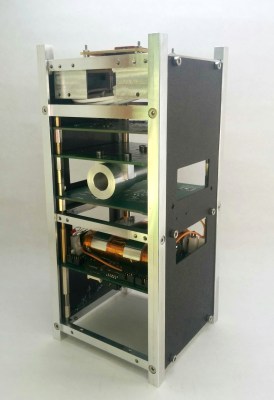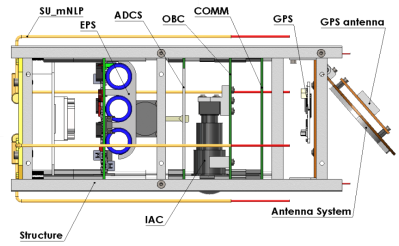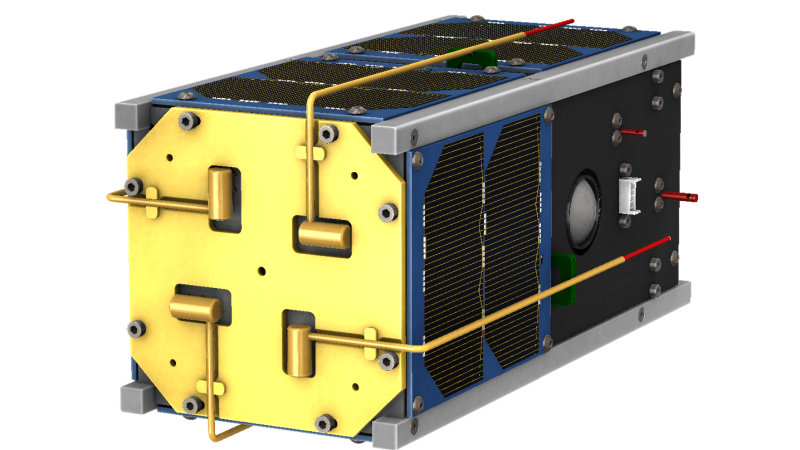When Hackaday announced winners of the 2014 Hackaday Prize, a bunch of hackers from Greece picked up the grand prize of $196,418 for their SatNOGS project – a global network of satellite ground stations for amateur Cubesats.
 The design demonstrated an affordable ground station which can be built at low-cost and linked into a public network to leverage the benefits of satellites, even amateur ones. The social implications of this project were far-reaching. Beyond the SatNOGS network itself, this initiative was a template for building other connected device networks that make shared (and open) data a benefit for all. To further the cause, the SatNOGS team set up the Libre Space Foundation, a not-for-profit foundation with a mission to promote, advance and develop Libre (free and open source) technologies and knowledge for space.
The design demonstrated an affordable ground station which can be built at low-cost and linked into a public network to leverage the benefits of satellites, even amateur ones. The social implications of this project were far-reaching. Beyond the SatNOGS network itself, this initiative was a template for building other connected device networks that make shared (and open) data a benefit for all. To further the cause, the SatNOGS team set up the Libre Space Foundation, a not-for-profit foundation with a mission to promote, advance and develop Libre (free and open source) technologies and knowledge for space.
Now, the foundation, in collaboration with the University of Patras, is ready to launch UPSat – a 2U, Open Source Greek Cubesat format satellite as part of the QB50 international thermosphere research mission. The design aims to be maximally DIY, designing most subsystems from scratch. While expensive for the first prototype, they hope that documenting the open source hardware and software will help kickstart an ecosystem for space engineering and technologies. As of now, the satellite is fully built and undergoing testing and integration. In the middle of July, it will be delivered to Nanoracks to be carried on a SpaceX Dragon capsule and then launched from the International Space Station.
A typical Cubesat like this one consists of several sub-systems. The main one being the structural unit that holds it all together. The Electrical Power Subsystem (EPS) module produces, stores, distributes and controls the Cubesat’s electrical power. The Science Unit (SU) is the main payload, consisting of a multi-needle Langmuir Probe instrument which works by measuring the current collected individually from four needle probes, placed in front of the satellite.
T he secondary payload is the Image Acquisition Component (IAC) that does terrestrial imagery using a DART4460 Linux embedded board running a custom build of OpenWRT, a Ximea MU9PM-MH USB Camera and a 50mm lens attached to the camera, providing resolution between 11 m to 18 m per pixel depending on the Satellite’s altitude. The Attitude Determination and Control Subsystem (ADCS) stabilizes the satellite and orients it in desired directions during the mission.
he secondary payload is the Image Acquisition Component (IAC) that does terrestrial imagery using a DART4460 Linux embedded board running a custom build of OpenWRT, a Ximea MU9PM-MH USB Camera and a 50mm lens attached to the camera, providing resolution between 11 m to 18 m per pixel depending on the Satellite’s altitude. The Attitude Determination and Control Subsystem (ADCS) stabilizes the satellite and orients it in desired directions during the mission.
The On Board Computer subsystem (OBC) is the brains of the satellite. It facilitates all core flight functionality and implements all major decision-making and monitoring of all subsystems. At its heart is a STM32F4 microcontroller running a customised version of FreeRTOS. Ground communication is implemented using ECSS-CCSDS telemetry and telecommand packet standard as defined by ECSS-E-70. The on-board Communications Subsystem (COMM) is based on the CC1120 RF Transceiver chip, a device that has been employed successfully in previous missions.
All of the extensive project documentation is available on their GitHub Repository, and blog posts on their website record the major milestones along their journey, so do check it all out. And then keep a lookout for announcement of the launch and deployment of the UPsat sometime in July. In the meanwhile, check out this post announcing the winners of the 2014 Hackaday Prize. May the Force be with you, UPsat.




















SatNOGS has their whole approach upside down. “The design demonstrated an affordable ground station which can be built at low-cost and linked into a public network to leverage the benefits of satellites…”
Nonsense. I still do not see an affordable simple ground station solution. And now these guys are running off to build satellites. Pffft…
The central problem with the (seemingly now abandoned) ground station is the azimuth-elevation drive, it is still too complex and hard to source parts for. Without a truly innovative 2-axis antenna rotor solution, the number of ground stations will never flourish.
Fix this problem and you would be much closer to actually fulfilling what you originally pitched with SatNOGS. We don’t need more CubeSats right now. Heck there seems to be new publicly accessible CubeSats popping up every week! Put the money into properly finishing the earth station instead.
Too much inaccuracies in that comment. SatNOGS ground station is not abandonded. At least get your facts straight.
Since we don’t need any more Cubesats can you point me to the source code and schematics of an existing one? Since we have so many there should an Open Source one, right?
Hey Drone, Pierros here from LSF (SatNOGS). I would like to address some of your comments:
– On affordability. SatNOGS still is the easiest most affordable ground station solution out there (let alone being the only open source). Indeed it could get better, but for the first time there is an opportunity for the global open source community to engage in this effort and make it better, meeting the high standards for precise satellite signal tracking and acquisition. If you have any suggestions around making it more affordable and reliable please do engage in our community (community.satnogs.org)
– On embarking towards a satellite. We believe that operating an actual satellite would tremendously help improve the ground station solution. Without access to command and control interfaces and processes it is really hard to engage with existing satellite operators and improve the overall platform. Especially as there are no open source, thoroughly documented satellites, it is most of the times *really* difficult to know what should you track, decode, keep and update on the ground station segment. That’s why we believe that embarking on an open source satellite (with absolute minimal financial investment on our side) would have a great impact on the ground station itself.
– On flourishing the network. We are about to run a process of giving away (for free) 30 ground station kits to hackerspaces, makers and hackers around the world. This is a significant investment on our side (interestingly more expensive than our investment to the open source satellite) which shows our commitment to grow our open network to an unprecedented scale for a satellite ground station network.
Feel free to reach out (here or privately) for a more constructive conversation around those issues. Thanks for your input.
Since you are posting here I have a few more questions.
1) What is your expected unit cost for the complete unit? Did you do a cost analysis before you started or did you just wing it.
2) What sort of life span do you expect? What will be the thing that goes out first? Will it be a power source running out or some subsystem dying from exposure? Did you do an analysis of robustness before you started to get an idea of what space is going to do to the electronics?
3) How much is the launch cost? Even if you are piggybacking on someone else’s rocket and you aren’t paying anything out of pocket personally it’s still not free. If you were unassociated with anything, how much would it cost?
4) What is your main motivation for having this unit in space? Will it serve a purpose besides having a radio blip that people on the ground can say they listened to?
5) Say the rocket explodes, or a battery wire shakes loose on launch, or something else happens so you effectively don’t get to play with your toy and it’s lost forever. Are you going to make another one or are you going to cut your losses and find another hobby?
1) Almost 30k, but interestingly the bulk amount (~20k) is the solar panels (which we could not make as open source hardware). Analysis was done, and we were not much off.
2)For cubesats ejected from ISS without active propulsion you would expect anything from 5month to more than a year. For such a lifespan you would not expect any system to die, but rather the whole thing to burn in re-entry.
3)Nanoracks quotes 60k for a 2U non-profit cubesat (double that for for-profit). There are cheaper options out there, but not as frequent and easy to get by. For us it was considerably less as we are part of the QB50 European program.
4)The primary payload is the mNLP Science Unit (https://upsat.gr/?page_id=28), but we also have a secondary image acquisition payload. Finally big part of the mission is to be able to design, document, build and integrate all subsystems in an open source software and hardware way.
5)This is definitely not an one-off for us. We are strongly determined as Libre Space Foundation to develop and advance an open source ecosystem for space, so this is just the start.
Hello ppapadeas,
Thank you for the reply.
– On affordability: SatNOGS may be as you claim, “the easiest most affordable ground station solution out there”, but you miss my point: It’s not easy and affordable enough. In my opinion, there is still a huge gap between what’s available today in terms of Az-El drives, and what’s needed.
– On embarking towards a satellite: I still disagree. Until the ground segment is truly affordable and simple, putting resources into a spacecraft is mis-guided, especially when there are so many satellites in-orbit and planned for launch.
– On flourishing the network: Giving away earth stations doesn’t solve the problem of the earth station being too complex and costly. Until the earth station can be easily procured and affordably built, the growth of earth stations will not be self sustainable. Having to give away earth stations to grow the network is a sign of a problem – not a solution.
All said, I have lots of respect for what you’re trying to do. But we’ll just have to disagree on how to do it.
Believe me, I understand how hard it is to do what I’m asking. If I was smarter and/or had more time to spend on something like this, I would do it myself.
Good Luck, David
Fascinating!
I am curious by what mechanism the ADCS stabilizes and controls the satellite. I was expecting to see some kind of physical control system (RCS, spinning flywheels, magnetic coils, dilithium chamber, etc.), but I missed it. Either that or it was removed to allow photography of the innards of the satellite?
Well done, SatNOGS team! This is a great achievement, and I hope that the launch goes well for you!
From here (https://upsat.gr/?page_id=26) it looks like they’re using magnetotorquers attached to the body of the SV. For something that small and low-mass, that’s probably the simplest and most reliable approach to take. Super cool!
I met some of the SatNOGS team in Dayton last year – it was really cool to see their ground station set up. Wat
And now an open source satellite – great stuff! Keep up the good work!
I couldn’t find what type of GPS they were using.
Is it a special GPS with high cost certifications as required to get around ITAR regulation on space operation, or is it homebrew?
We love satellites! And there are thousands of them up there. SatNOGS provides a scalable and modular platform to communicate with them. Building it at a low-cost would mean it has low quality.